Boletus L.
Recent molecular studies have shown that Boletus in its current circumscription is likely an artificial grouping and it is possible that it will be split at some point into smaller genera. Note that Boletus impolitus and Boletus depilatus for practical reasons are retained here, although there is strong evidence that they are closely related to Xerocomus subtomentosus and its allies.
Fruitbody large to medium sized, boletoid, without veil and ring. Stipe solid, with surface usually covered with granules or network. Flesh variously coloured, changing or not when exposed to air. Tubes easily separable from each other, not tearing apart. Pores usually small and rounded.
Boletus torosus Fr.
Description
Cap up to 20 cm, at first hemispherical, then convex to flat-convex, greyish, dirty whitish with some ochraceous tints, yellowish white, yellow, ochraceous to brownish, gradually developing olivaceous tint with age, sometimes spotted orange or reddish, dry, smooth, blueing strongly when bruised. Stipe clavate, bulbously swollen at the base or cylindrical; almost entirely cream, lemon yellow to bright yellow, often spotted reddish or rusty, covered throughout with well developed fine, whitish, yellow, reddish or brownish network, blueing when bruised. Tubes at first lemon yellow, then bright yellow, finally with somewhat olivaceous tint, blueing when damaged. Pores concolorous with the tubes, blueing when bruised. Flesh lemon yellow, blueing strongly when exposed to air. Smell somewhat unpleasant. Taste not distinctive. Spores 13–16 × 5–6.5 μm, ratio 2.2–2.7. Pileipellis (the cap cuticle) trichodermium of interwoven septate hyphae of cylindrical, finely incrusted cells. Chemical reactions: hyphae of the flesh in the stipe base amyloid with Melzer’s solution.
Habitat. Warm broadleaf forests usually on calcareous soils, mycorrhizal with oaks (Quercus), beech (Fagus) or sweet chestnut (Castanea).
Distribution. Seen throughout much of Europe and reaching Caucasus in the east, but seldom everywhere; apparently a southern species, that is absent in north.
Similarity. Boletus torosus is one of the few European Luridi with yellow pores, slightly similar to Boletus poikilochromus. In the past and even nowadays it is sometimes confused with Boletus luteocupreus, the later having red pores. Compare also with Boletus radicans which has distinctly bitter flesh.
Photographs

Fruitbodies of Boletus torosus. (photo M. Danz)

Fruitbodies of Boletus torosus. Note the lemon yellow pores and the strong blueing reaction where the fruitbodies were handled (photo M. Danz)

Fruitbodies of Boletus torosus. (photo M. Danz)
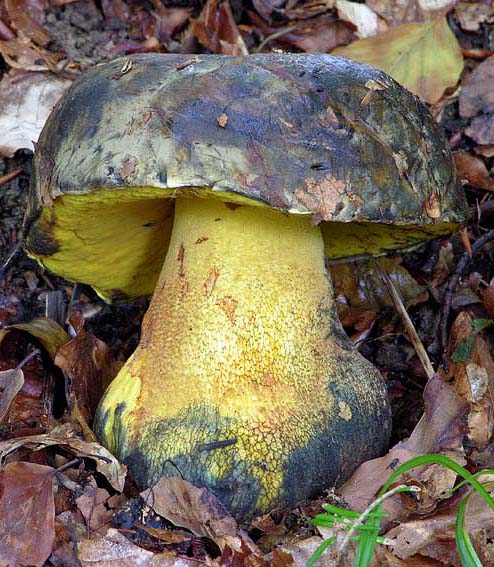
Mature fruitbody of Boletus torosus. Note the prominent network on the stipe. (photo M. Danz)
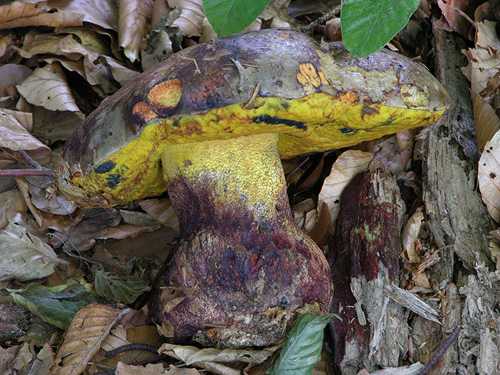
Mature fruitbody of Boletus torosus. Vinaceous colouring is often gradually developed on the stipe with age. (photo M. Danz)
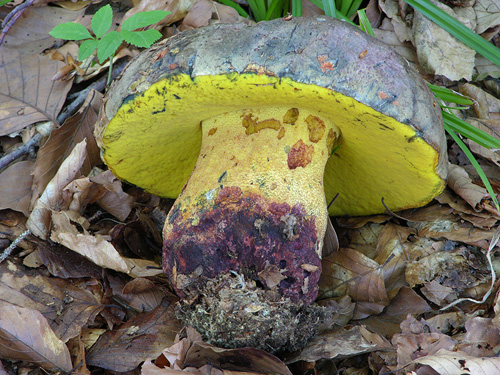
Well developed fruitbody of Boletus torosus. (photo M. Danz)
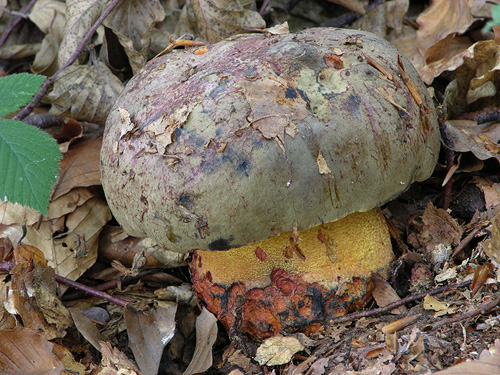
Young fruitbody of Boletus torosus. (photo M. Danz)
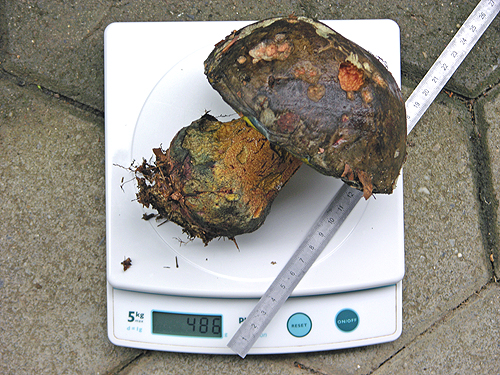
Boletus torosus features extremely dense and heavy flesh. As seen from the photo this fruitbody measuring about 11 cm across weights nearly half a kilogram. (photo M. Danz)
Important literature
Alessio, C.L. 1985. Boletus Dill. ex L. (sensu lato). – In: Fungi Europaei. Vol. 2. Pp. 1–705. Libreria editrice Biella Giovanna, Saronno.
Brillouet, J.-M. & Brillouet, T. 1993. Descrizione comparativa di raccolte di Boletus xanthocyaneus Ramain ex Romagnesi e di Boletus torosus Fries. – Rivista di Micologia 36(1): 65–72.
Engel, H., Krieglsteiner, G., Dermek, A. & Watling, R. 1983. Dickröhrlinge. Die Gattung Boletus in Europa. Verlag Heinz Engel, Weidhausen b. Coburg.
Estadès, A. & Deïana, J.C. 2004. Boletus xanthocyaneus et Boletus torosus. Deux espèces distinctes. – Bulletin Mycologique et Botanique Dauphiné-Savoie 127: 15–30.
Estadès, A. & Lannoy, G. 2004. Les bolets européens. – Bulletin Mycologique et Botanique Dauphiné-Savoie 44(3): 3–79.
Galli, R. 1998. I Boleti. Atlante pratico-monographico per la determinazione dei boleti. Edinatura, Milano.
Hills, A. 1997. Notes on British species of the Boletus torosus complex. – Mycologist 11: 159–164.
Lannoy, G. & Estadès, A. 2001. Les Bolets. Flore mycologique d’Europe. Documents Mycologiques Mémoire Hors série no. 6. Pp. 1–163. Association d’Écologie et de Mycologie, Lille.
Muñoz, J.A. 2005. Boletus s. l. – In: Fungi Europaei. Vol. 1. Pp. 1–951. Edizioni Candusso, Alassio.
Pilát, A. & Dermek, A. 1974. Hríbovité huby. Československé hríbovité a sliziakovité huby (Boletaceae – Gomphidiaceae). Veda, Bratislava.
Redeuilh, G. 1992. Contribution à l’étude des bolets. II: Etude critique de Boletus torosus et Boletus xanthocyaneus. – Bulletin trimestriel de la Société mycologique de France 108: 155–172.
Simonini, G. 1995. I Boleti della sezione Luridi a viraggio violento: problemi tassonomici. – Mycologia e Vegetazione Mediterranea 10: 88–112.
Simonini, G. 1998. Qualche specie rara o poco conosciuta della famiglia Boletaceae. – In: Fungi non delineati. Vol. 6. Pp. 1–56. Libreria Mykoflora, Alassio.
Šutara, J., Mikšík, M. & Janda, V. 2009. Hřibovité houby. Čeled’ Boletaceae a rody Gyrodon, Gyroporus, Boletinus a Suillus. Academia, Praha.
Watling, R. & Hills, A.E. 2005. Boletes and their allies (revised and enlarged edition). – In: Henderson, D.M., Orton, P.D. & Watling, R. [eds]. British Fungus Flora. Agarics and boleti. Vol. 1. Royal Botanic Garden, Edinburgh.